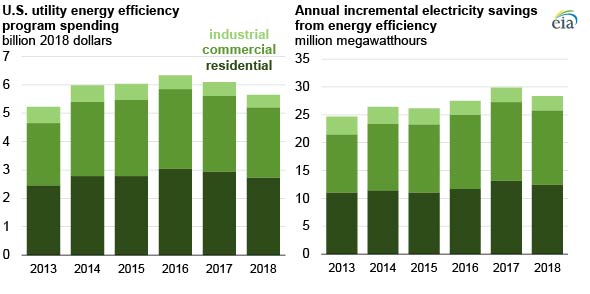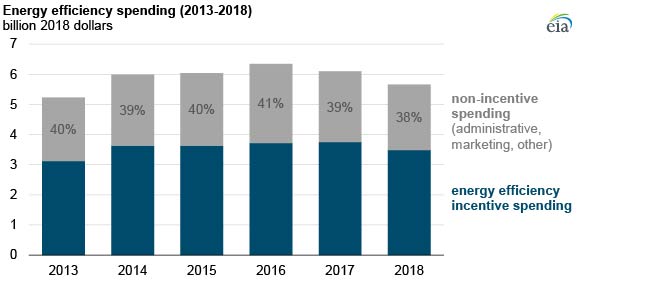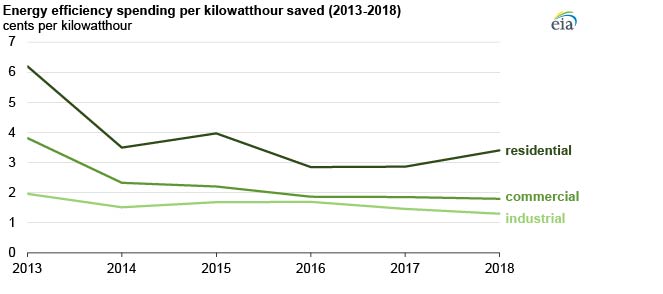
The U.S. Energy Information Administration’s (EIA) annual survey of more than 600 electric utilities and third-party program managers shows that total inflation-adjusted energy efficiency (EE) spending and electricity savings fell in 2018 as the cost of achieving savings increased in the residential sector. EE spending fell for the second year in a row, in part, because of less administrative, marketing, and other spending not directly related to energy efficiency incentives. Since 2014, reported energy efficiency savings have increased by 7%, and energy efficiency incentive spending has declined by 6%.
Energy efficiency measures are efficient devices or processes that exceed current efficiency standards and generate long-term, continuous reductions in electricity demand. Examples include installing a more efficient lightbulb or improving the insulation in a home.

Part of the decline in spending in 2018 is related to lower program spending not directly related to energy efficiency incentives. These costs could include administration; marketing and education; and evaluation, measurement, and verification. As a percentage of total EE spending, non-incentive spending fell from a high of 41% in 2016 to 38% in 2018. Direct spending on EE incentives also fell by $261 million between 2017 and 2018, a 7% decline.
Reported incremental annual EE savings in 2018 declined by about 5% from 2017 levels. This decrease marks the largest year-over-year decline since 2006, when savings dropped by 8%. Although reduced savings occurred nationwide, many states with the highest reported savings experienced double-digit declines from 2017 to 2018, including Arizona (15%) and California (10%).
Incremental annual spending and savings reflect new participants or new programs, and they take place in the reporting year. Incremental lifecycle spending and savings account for all spending and savings for new programs or participants, even after the first year of the program.

Although the average cost of energy efficiency savings has declined since 2013, this trend has slowed in recent years, and the residential sector experienced an uptick in cost from 2017 to 2018. The cost of commercial saved energy has remained mostly flat since 2016. The residential sector has had the highest cost of saved energy in each of the past five years, most recently averaging 3.4 cents per kilowatthour saved on a lifecycle basis in 2018.
To date, programs supporting efficient lighting, such as light-emitting diodes (LED), have accounted for a large portion of utility energy efficiency savings. However, because these bulbs have now achieved substantial market penetration in general-service lighting, some efficiency programs are turning to other technologies to find efficiency savings. Data from the National Electrical Manufacturers Association show that the share of efficient lighting options such as LED and compact fluorescent lighting represented about 75% of general-service lighting sales in the first half of 2019.
Utility EE spending is driven in part by state energy efficiency resource standards (EERS), which set mandatory, long-term energy- use reduction targets. The assumptions to EIA’s Annual Energy Outlook 2020 (AEO2020) list EERS standards and non-binding goals and pilot programs in effect as of December 2019.



Follow us on social media: